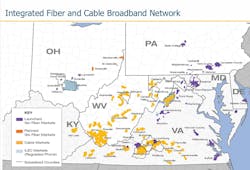Shentel's CEO: Residential Glo Fiber and commercial fiber to surpass incumbent revenues next year
Key Highlights
Shentel added more fiber subscribers and deepened its fiber passings during the second quarter.
During the quarter, Shentel added 5,700 new Glo Fiber subscribers and over 16,000 new Glo Fiber passings.
Shentel’s engineering team reached a key milestone in the second quarter, installing over 500 new route miles of fiber.
The service provider also saw an uptick in commercial fiber orders.
Shentel’s ongoing fiber build has become a transformational element that reflects its ongoing migration from being a traditional telco and cable video provider to a fiber-centric service provider.
Speaking to investors during its second-quarter earnings call, Christopher French, the outgoing CEO of Shentel, said its sales pipeline shows that fiber is on track to become the company's dominant revenue driver.
“Although it's expected to take a couple of quarters to install and convert these sales into revenue, sales bookings are an early indicator of future growth,” he said. “Combined, we expect Glo Fiber residential and commercial fiber revenues to be larger than our incumbent revenues in 2026. It's been gratifying to see the transformation from a mature cable and telephone operator into a rapidly growing fiber-first business.”
Based on its second-quarter results, Shentel is well on its way to making this goal a reality.
During the quarter, Shentel added 5,700 new Glo Fiber subscribers and over 16,000 new Glo Fiber passings. Glo Fiber revenues grew 40.5% over the same period in 2024 to $19.8 million. On a year-over-year basis, Shentel grew its customer base by 43%, ending the second quarter with over 76,000 Glo Fiber subscribers. Shentel’s total Glo Fiber revenue-generating units reached 90,000 at the end of the quarter, up 40% year-over-year.
Likewise, Shentel’s commercial fiber business reported $200,000 in monthly recurring revenue sales bookings.
“Our results build on the evolution of Glo Fiber over the past 6 years,” French said. “I'm very proud of what our team has accomplished to build a thriving $80 million revenue line of business with almost 380,000 total passings.”
Advancing fiber reach
A key focus for Shentel during the second quarter was on advancing its fiber reach. The service provider’s integrated broadband network now spans over 17,700 route miles across eight states.
Shentel’s engineering team reached a key milestone in the second quarter, installing over 500 new route miles of fiber. This included 16,000 new Glo Fiber passings, 3,000 new subsidized passings in its incumbent broadband markets and connections to additional commercial fiber customers.
“We now pass approximately 623,000 homes and businesses with broadband services and Glo Fiber represents about 61% of these passings,” said Edward McKay, Shentel’s current EVP and COO, who will take the CEO reins in September.
The service provider also saw an increase in broadband penetration and a decrease in churn. Broadband penetration rose 20% in Glo Fiber markets, up from approximately 18% a year ago, and monthly broadband data churn for the second quarter improved year-over-year to 1.15%.
ARPU also remained steady in the second quarter. “Broadband data average revenue per user remained strong in the second quarter at roughly $77, supported by customer adoption of higher speed tiers,” McKay said. “In the quarter, 53% of new residential subscribers chose speeds of 1 gig or higher, including 9% adopted speeds of 2 gigabit or higher.”
Growth in its Glo Fiber markets has followed what Shentel said is a consistent, predictable pattern with steady increases in data penetration rates as cohorts mature.
“We typically achieve 15% data penetration rates within the first year and 25% by year 3,” McKay said. “Our earliest cohorts launched in 2019 and 2020 now have an average data penetration rate of 36%. We're also pleased with our sales and marketing team's ability to quickly engage customers when launching new neighborhoods, as demonstrated by our 9% penetration rate for communities introduced in the second quarter.”
In its incumbent telco and cable broadband markets, Shentel had about 112,000 broadband data customers, reflecting what McKay said was “a slight year-over-year increase.”
Data, voice and video RGUs totaled 161,247 at the end of the second quarter, down 3% year-over-year, primarily due to video customers moving to online streaming options. Monthly broadband data churn improved 10 basis points year-over-year, reaching 1.59% in the second quarter.
Glo fiber drives revenue
Glo Fiber was once again the star in Shentel’s revenue mix.
Driven by another quarter of strong Glo Fiber residential and small to medium business (SMB) market revenue growth of $5.7 million or 40.5%, driven by an increase in subscribers, total revenue rose 3.2% to $88.6 million.
However, legacy declines continued to be a drag. Residential & SMB - Incumbent Broadband Markets revenue decreased due to lower video revenue driven by a 14.5% decline in video RGUs.
Jim Volk, CFO of Shentel, said that “the Glo Fiber revenue growth was partially offset by declines in incumbent broadband markets and commercial fiber revenue of $1.4 million and $1.2 million, respectively.”
The decline in commercial fiber revenue was due to $0.8 million in non-cash deferred revenue adjustment for a modified carrier contract and $0.9 million in early termination fees earned in the prior year.
Volk said, “excluding these variances, Commercial Fiber revenue grew 2.7% over the prior period 2024.”
Looking forward, Shentel has forecast 2025 revenues to be $352 million to $357 million and adjusted EBITDA to be $113 million to $118 million. CapEx, net of grant reimbursements, is expected to be $260 million to $290 million.
“For the full year, we expect capital investments to be in the $260 million to $290 million range, net of $55 million to $65 million in government subsidies,” McKay said. “This is slightly higher than our previous guidance, primarily because we've accelerated incumbent broadband grant projects and network upgrades from 2026 to 2025.”
For related articles, visit the Business Topic Center.
For more information on high-speed transmission systems and suppliers, visit the Lightwave Buyer’s Guide.
To stay abreast of fiber network deployments, subscribe to Lightwave’s Service Providers and Datacom/Data Center newsletters.
About the Author
Sean Buckley
Sean is responsible for establishing and executing the editorial strategy of Lightwave across its website, email newsletters, events, and other information products.




